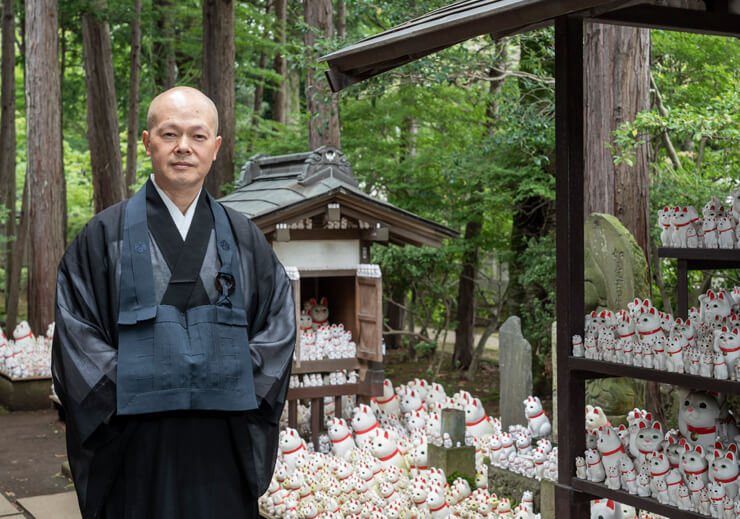
 Ride the Manekineko Densha
Ride the Manekineko Densha Mr. Tessai Kasukawa Chief Priest, Gotoku-ji Temple


TOP > Kofuku-no-Manekineko Densha > Chief Priest, Gotoku-ji Temple

In ancient times, Gotoku-ji Temple’s manekineko was actually called “manegineko” (招福猫児). Mr. Kasukawa says, “My guess is that the soft gi of manegineko was a reference to the gi from the word engi (縁起: luck). However, these days it is called manekineko, without the softened pronunciation.” The simple design with the raised right paw is modeled after a white cat named “Tama” who brought luck to the temple some 400 years ago. It is estimated that there are as many as 10,000 manekineko placed at the dedication altar, which is an indicator of just how famous the figurine is. “People come for the spacious grounds and quiet spaces growing thick with trees, of course, but recently we’ve also had many foreign visitors who come specifically to see the manekineko,” Mr. Kasukawa says. People often ask him about the proper way of making a prayer with a manekineko, but he says, “Rather than offering it right away, you can take it home and display it. And when a wish is answered, or a new year arrives, you can offer it then. Or you can simply decorate your home with it. I think the best thing is for people to do it their own way.”

Of course, we all know that cats have something mysterious about them. Tama is said to have been an incarnation of Shofuku Kannon, the goddess of mercy and bringer of good luck. Mr. Kasukawa says, “Back then, the high priest had a cat that he cherished, and I think the Kannon responded to the priest’s feelings by calling good luck through the cat.” Cats and dogs have had an intimate relationship with humans since ancient times. And it is said that cats connect people with the Buddha. Although Gotoku-ji Temple does not keep a pet cat now, the chief priest says, “A stray cat comes by for food three times a day. I say, ‘I hope you’ll return the favor,’ but of course, I must not hope for that. I wonder if someday a helping hand will be extended to me in return for feeding the cat.” Of course, the stray’s name is “Tama.” It seems that on this day it came around at 5:30 in the morning.

Mr. Kasukawa says, “When I heard what Tokyu Railways had in mind, I said I’d love to see a manekineko themed train on the tracks.” Several hurdles had to be overcome along the way, but eventually the train became reality. The train is painted pure white, a color not typically seen on other trains, after Gotoku-ji Temple’s manekineko. “I really like how the train looks when it’s approaching on tracks covered with grass,” says the chief priest with a smile. The truth is, he hadn’t had the opportunity to ride the Manekineko Densha until just recently. “I was waiting at the station when I heard the railroad crossing bell” he says. “I wished, ‘Please let it be the Manekineko Densha,’ and it was! I couldn’t help but smile as I boarded. And then my return train was also the Manekineko Densha! I was delighted to have had such a lucky day.”

The locals are very fond of the Setagaya Line and their affection has only grown with the arrival of the Manekineko Densha. Whenever someone shouts, “Hey, it’s the Manekineko Densha!” everyone looks and feels a glow of happiness. The chief priest says, “I hope people will pass on such joyful feelings to others.” He adds genially, “Positive vibes are contagious. If we see the Manekineko Densha and feel happy, we can take that feeling home and share it with others. I think that’s important.” It seems the manekineko of Gotoku-ji Temple, a legacy from long ago, has been reborn as a train and will keep putting smiles on people’s faces for the foreseeable future.


